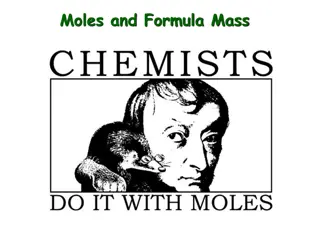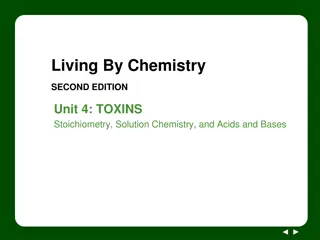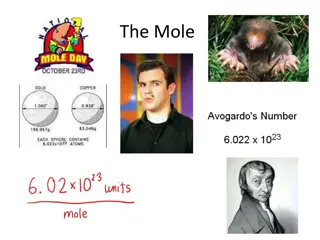Understanding Molar Mass and Avogadro's Number in Chemistry
Explore the concept of molar mass and Avogadro's number in chemistry through lessons on translating numbers into scientific notation, understanding moles, and finding molar mass on the periodic table. Discuss the relationship between mass and moles, differentiate between different quantities of a substance, and learn to convert between moles and grams using scientific notation.
Download Presentation

Please find below an Image/Link to download the presentation.
The content on the website is provided AS IS for your information and personal use only. It may not be sold, licensed, or shared on other websites without obtaining consent from the author. Download presentation by click this link. If you encounter any issues during the download, it is possible that the publisher has removed the file from their server.
E N D
Presentation Transcript
Living By Chemistry SECOND EDITION Unit 4: TOXINS Stoichiometry, Solution Chemistry, and Acids and Bases
Lesson 76: Billions and Billions Avogadro s Number
ChemCatalyst Which do you think is more toxic, 1 mol of arsenic, As, or 10 g of arsenic? Explain your reasoning.
Key Question What is the relationship between mass and moles?
You will be able to: translate numbers into scientific notation, and vice versa explain the magnitude of a mole define molar mass for an element and find its value on the periodic table
Prepare for the Classwork Work individually or in pairs. 1 mole 602,000,000,000,000,000,000,000, or 602 sextillion
Discussion Notes Scientific notation is a convenient way to write numbers that have lots of zeros, either because they are very large or because they are very small.
Discussion Notes (cont.) A number in standard notation can be converted to scientific notation by writing it as a decimal with one digit to the left of the decimal point times a power of ten. Move the decimal point four places to the right. Move the decimal point four places to the left. 1.56 X 104 = 15,600 1.56 X 10 4 = 0.000156
Discussion Notes (cont.) Very small amounts of a substance contain enormously large numbers of atoms. The mole is simply a counting unit. 1 mole = Avogadro s number = 602 sextillion = 602,000,000,000,000,000,000,000 = 6.02 X 1023 The mass of 1 mol of a substance is called the molar mass.
Wrap Up What is the relationship between mass and moles? One mole of a substance is equal to 602 sextillion or 602,000,000,000,000,000,000,000 objects. This is also called Avogadro s number. Scientific notation is a convenient way to express numbers that have many zeros. The atomic mass given on the periodic table is equivalent to the mass of 1 mole of atoms of the element in grams, called molar mass. Molar mass allows you to convert between moles of atoms and grams of atoms.
Check-In If you have 1 mol of aluminum and 1 mol of iron, which has more mass? How many atoms are in each sample?























